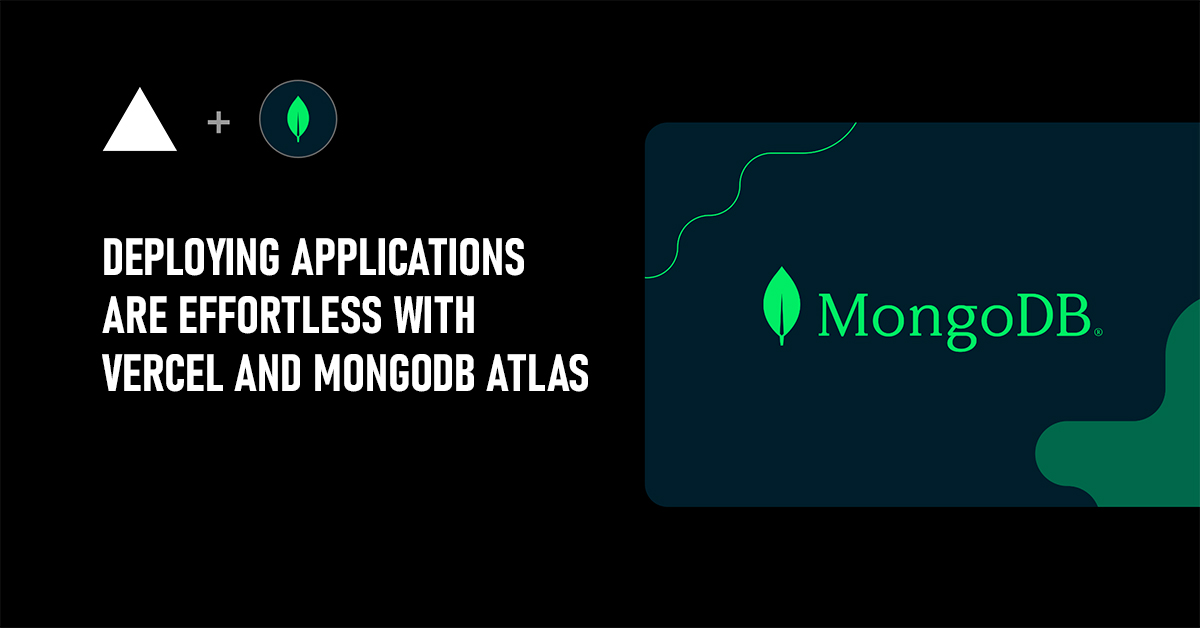Deploying applications are effortless with Vercel and MongoDB Atlas.

Data Analyst
Experienced data analyst working with data visualization, cloud computing and ETL solutions.
July 05, 2022

The release of Vercel-MongoDB integration is a major development that will simplify and standardize the way data from different sources are stored in your database. You can now leverage all sorts of powerful features without having an intricate understanding of how they're implemented, as this new tool takes care of everything automatically.
Using the new official integration between MongoDB and Vercel makes it easier than ever to seamlessly connect your application. This article will walk you through how easy this is, and reasons why you should use them.
The integration between your Vercel and MongoDB Atlas infrastructure comes all the way down to a single environmental variable. The official integration handles defining this for you, together with any required permissions that are necessary to make it work seamlessly as possible within both environments - on-premises or cloud-hosted.
Reasons why you should deploy your applications with Vercel-MongoDB
1.Vercel-MongoDB Atlas is a cloud-based platform that makes deploying MongoDB easy and fast
Vercel-MongoDB Atlas is a cloud-based platform that makes deploying MongoDB easy and fast. With Vercel, you can deploy MongoDB in seconds, and it integrates with your existing infrastructure so you can get up and running quickly. It also offers several tools for monitoring and optimizing performance. In addition, Atlas makes it easy to connect to MongoDB from your application or website. With its simple, intuitive interface, you can get started quickly and easily deploy MongoDB in the cloud.
2. It offers automated backups, security features, and scalability to ensure your data is always safe.
Vercel-MongoDB Atlas is a powerful combination of products that offers data safety, security features along with scalability. With automated backups and security features, it helps to keep your data safe while allowing you to scale your database as needed. The product also ensures that your data is always available by replicating it across multiple servers. This provides high availability and fault tolerance in the event of a single server failure. In addition, the product offers several management features to help you keep track of your data and manage your database efficiently. Overall, Vercel-MongoDB Atlas is ideal for anyone looking for a reliable and scalable database solution.
3. Vercel-MongoDB Atlas is cost-effective, making it a great option for small and medium businesses
Vercel-MongoDB Atlas is a cost-effective solution for small and medium businesses. It offers all the features of MongoDB Atlas at a fraction of the cost. With Vercel-MongoDB Atlas, you get all the benefits of MongoDB Atlas without the expensive price tag. You can use Vercel-MongoDB Atlas to host your website, blog, or e-commerce store. It is also great for small and medium businesses that want to take advantage of MongoDB’s powerful features but do not want to break the bank. So if you are looking for a cost-effective solution that still offers all the features of MongoDB Atlas, then Vercel-MongoDB Atlas is the perfect option.
4. The platform is constantly being updated with the latest features and enhancements
The Vercel-MongoDB Atlas platform is constantly being updated with the latest features and enhancements. One of the most recent additions is a new data visualization tool that makes it easy to see how your data is organized and where it is located. This is especially useful for large data sets, as it can be difficult to keep track of all the information without a visual aid. The tool also includes a search function, to quickly find specific data points. In addition, the platform now supports multiple languages, making it even easier to use for international users. With these new features, the Vercel-MongoDB Atlas platform is becoming an increasingly powerful tool for managing and analyzing data.
5. You get access to expert support from the Vercel team if you need help with your deployment
At Vercel, they provide expert support to customers. Whether you are just getting started with your first deployment or you are a seasoned pro, the team is there to help. They offer variety support options, including email, chat, and phone support. So whatever your needs, Vercel has you covered.
Now that you know the reasons to use Vercel-Mongo DB to deploy your application let us see how it is done .
The first thing you need is an application to deploy. Once you have created your fully functional app, everything should work as expected.
The prod setup of Vercel-MongoDB
To produce a scalable and efficient system, first, we must create our development environment. We will use the same concept for production by setting it up as if this were going into an actual live service with various stages of testing/staging before being promoted permanently onto your company’s main website or app store run on MongoDB databases stored locally within each instance's data centers.
The best way to get started with database management software is by setting up two accounts: one in Vercel and another at MongoDB Atlas. Both services offer free hobby-level databases that are quick, easy-to-use tools for beginners.
Vercel project importing
Simply log into Vercel with your accounts, create a new project and start importing the code from GitHub. You can do this by clicking on the continue with GitHub tab.
Once the project is successfully imported, a message will appear on the screen telling you that Vercel has automatically generated and deployed your project. But there's no data store available yet so all it does for now is display an error when viewed in isolation, to show this part of their work done successfully.
Generate a MongoDB Atlas cluster
Now that you have a free cluster in MongoDB Atlas, it’s time to create your production data home base. To do this using the console is straightforward. You get started by creating an account on MongoDB-atlas with user privilege defined for yourself.
Going back to Vercel to add integration
Once you have a cluster available for use, the next step is to add MongoDB integration with your Vercel user account. Navigate over https://vercel-com/integrations and click on “Add Integration” at the top of screen so that it will open up in modal form where there are options provided by selecting an already existing system or creating one yourself based on these choices.
Going back Temporarily in MongoDB Atlas
The integration will launch a MongoDB signup page in another window. If you don’t already have an account, you can set one up now or use the default that was given when signing into your existing user settings for this app provider (Mongo Atlas).
In next screen, it asks confirmation of access to the organization to add integrations with; just select “Yes" next to any boxes asking if they are true/respectful based on their policies.
Then it will show you your cluster and all the projects associated with it. If you want to add a new project, tap on “Add Project.” In this case, the Vercel project created previously is added to the right-hand selection that will be shown on the screen.
Now that you have connected your project with the right database, it's time to make sure everything is set up accurately.
You will need access permission on both databases for this process to go smoothly. First, let’s take care of setting up environment variables so they can be used by any application or codebase seamlessly across platforms without being configured differently per machine.
Back in Vercel for a testing
Coming back to Vercel, you will see the MongoDB Atlas integrations in the Integrations tab.
From here if you want you can make changes to the Vercel integration.
Next, we verify that the Vercel project has inherited a new environment variable that references an installation of the MongoDB Atlas. Open up your settings for this project and click on Environment Variables in the left menu where you should see one called MONGODB_URI .
The availability of environment variables is done by checking whether they are set in your code or not. When you click on the eye icon inside a variable, it will show whether that particular value points at any Atlas cluster - which can be helpful if one needs more information about their deployment.
When you click on the project to view it, now there will be data driven by Atlas.
Conclusion
The Vercel-MongoDB integration links the application as implemented in this framework to a database running within Atlas. A similar approach could be used for linking apps across different environments, such as testing or staging versus production mode settings on your machine where you want all data available without any delays due just because it's stored somewhere.
The optimization process has been made easier with this new integration, which will help you leverage global scale-to-zero infrastructure without any hassle.













